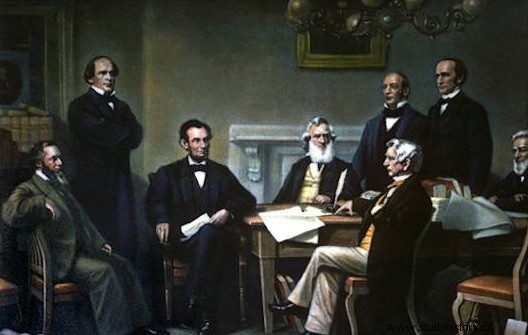 Enacted on January 1, 1863 in the midst of the American Civil War by President Abraham Lincoln, the Proclamation of emancipation of slaves targeted the slave states of the South. It had been preceded on September 22, 1862, by a preliminary proclamation announcing that from the following January 1 the slaves of the insurgent states or fractions of states would be "henceforth and forever free." The proclamation caused a stir around the world. It was not until Congress passed the famous 13th Amendment to the United States Constitution on December 18, 1865 that the abolition of slavery took on its universal character.
Enacted on January 1, 1863 in the midst of the American Civil War by President Abraham Lincoln, the Proclamation of emancipation of slaves targeted the slave states of the South. It had been preceded on September 22, 1862, by a preliminary proclamation announcing that from the following January 1 the slaves of the insurgent states or fractions of states would be "henceforth and forever free." The proclamation caused a stir around the world. It was not until Congress passed the famous 13th Amendment to the United States Constitution on December 18, 1865 that the abolition of slavery took on its universal character.
The context of the slave emancipation proclamation
Until then, the question of slavery had remained very secondary in the conduct of the war. The latter was delivered to restore the Union by bringing breakaway states back into the fold of the United States. It was to meet this war goal that the majority of northern soldiers had enlisted, and that public opinion supported the federal government in its pursuit. Elected on a moderate platform focusing on circumscribing slavery in states where it was already practiced, Lincoln had no intention of abolishing it. He had expressed his conviction in his famous “Divided House” speech in 1858:slavery was an archaic institution that would eventually disappear on its own once confined. It was this moderation that allowed the Republican presidential candidate of 1860 to win the states – Pennsylvania, Indiana, Illinois – that his predecessor John C. Frémont had failed to win in 1856.
The secession, and the war that followed, had however changed the situation . Abolitionists and radical republicans had quickly tried to take advantage of this new context to direct government policy towards the abolition of slavery. The year 1861 brought them little success, either vis-à-vis slavery as such, or on the more general question of the civil rights of blacks. The case law established in 1857 by the so-called “Dred Scott” judgment of the Supreme Court remained the norm:the approximately 344,000 free blacks who lived in the states that had not left the Union were not considered American citizens. Those who had enlisted in the volunteer army in 1861 had seen their enlistment refused. However, one of the corollaries of the conflict and the occupation of southern territories, in this case the arrival in the northern lines of an ever-increasing number of runaway slaves, was to change the facts of the problem.
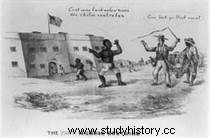 As representatives of the federal government, northern officers remained obligated to return runaway slaves to their owners, since the Fugitive Slave Act of 1850 was still in effect. However, several abolitionist generals, foremost among whom was Benjamin Butler, had from the first weeks of the conflict refused to apply it. Butler justified his refusal with a legal sleight of hand:since President Lincoln had decreed the blockade of the Confederacy on April 19, 1861, any good entering or leaving it could be considered as contraband and seized as such – including slaves. The first to officially change its attitude on the matter was the U.S. Navy. Citing humanitarian reasons, Union Secretary of the Navy Gideon Welles ordered as early as July 22, 1861, that the fugitives be kept and employed on secondary duties. A few days later, Congress voted, on August 6, a first Confiscation Act , a law authorizing the military to confiscate any property that might be useful to the Confederate war effort.
As representatives of the federal government, northern officers remained obligated to return runaway slaves to their owners, since the Fugitive Slave Act of 1850 was still in effect. However, several abolitionist generals, foremost among whom was Benjamin Butler, had from the first weeks of the conflict refused to apply it. Butler justified his refusal with a legal sleight of hand:since President Lincoln had decreed the blockade of the Confederacy on April 19, 1861, any good entering or leaving it could be considered as contraband and seized as such – including slaves. The first to officially change its attitude on the matter was the U.S. Navy. Citing humanitarian reasons, Union Secretary of the Navy Gideon Welles ordered as early as July 22, 1861, that the fugitives be kept and employed on secondary duties. A few days later, Congress voted, on August 6, a first Confiscation Act , a law authorizing the military to confiscate any property that might be useful to the Confederate war effort.
The Forfeiture Act of 1861 legalized a posteriori Butler's policy. However, the status of slaves who found refuge in the northern lines did not change:they were still enslaved. It was not a postage. As “property,” the fugitives were simply “seized” by the federal military, and became the property of the government instead of that of their previous master. Ironically enough, his presidential office made Lincoln, within a few months, the biggest slave “owner” in the whole country. The fugitives were employed by the northern army in a wide variety of secondary roles , earthworks and construction, various logistics tasks. Women and children were put to work for the laundry or the kitchen. Union soldiers stationed in the areas where fugitives were most numerous – in 1862, Louisiana and the Atlantic coast of the Confederacy – did not hesitate to use the "contrabands", as they were called, as personal servants . Their way of treating them, very variable, sometimes had nothing to envy to that which the escapees had wanted to flee when leaving their plantation.
 Radical Pressure
Radical Pressure
However, not all Union officers enforced this law, continuing to return runaway slaves to their owners. The issue of slavery remained politically sensitive, and Lincoln himself was in no hurry to strictly enforce the provisions of the Confiscation Act . Four slave states – Delaware, Maryland, Kentucky, Missouri – had remained in the Union, albeit with varying degrees of goodwill, and the northern president feared that their public opinion and their political class would swing into the secessionist camp. he interfered too openly with the servile institution. It is for this reason, mainly, that he contra initially all attempts by abolitionists to steer the conduct of war in this direction. Lincoln was intransigent. When Frémont voluntarily proclaimed the emancipation of the slaves of Missouri on August 30, 1861, the president ordered him to back down, and fired him when he refused.
Nevertheless, the prospect of a long war and the defeats inflicted on the Union towards the end of 1861 allowed the radical Republicans to gain influence in the government. . These partisans of a hard policy vis-à-vis the rebels, in the forefront of which we found the new Secretary of War Edwin Stanton or the representative of Pennsylvania Thaddeus Stevens, rallied Lincoln little by little to their views. They understood that the southern economy was largely based on slavery. Hitting the "particular institution" of the South was therefore tantamount to attacking the war effort directly. of the Confederates. The federal government eventually agreed and on March 13, 1862, a new law – Act Prohibiting the Return of Slaves – was passed by Congress. This time it explicitly forbade northern officers to send fugitive slaves back to where they came from. On the other hand, their status remained unchanged:they were still "contrabands" and were neither free nor allowed to enlist in the Union army. Emancipation was still not on the agenda. Naturally, this law did not apply to slave owners who remained loyal to the Union.
Not that the radical Republicans were not in favor of it, quite the contrary, but Lincoln and the more moderates continued to put the brakes on. When, in a move similar to that of Frémont the previous year, his friend David Hunter decreed the emancipation of all slaves in the military department under his charge – encompassing South Carolina, Georgia and Florida – President had no qualms about rescinding his order. Lincoln wanted to spare not only the slave-holding border states, but also its Democratic allies, whose support for the war was fragile and based essentially on the idea that it was fought to restore the territorial integrity of the Union – and not to liberate the slaves.
Nevertheless, the radical Republicans still gained influence in the wake of the military difficulties of the summer of 1862:beaten in Virginia, trampled in the West, the northern armies crossed again a bad pass. This was an opportunity for the radicals to impose a new hardening in the conduct of the war. The first step was taken on June 19, 1862, when Congress, overriding the Dred Scott jurisprudence, explicitly reaffirmed the prohibition of slavery in the territories.
A second Forfeiture Act was voted on July 17, 1862. It considerably reinforced the provisions of the first, greatly facilitating its application. But its main novelty concerned the status of fugitive slaves:they became legally freed as soon as they were “seized” by Union forces. No longer legally able to be considered "contraband" for this reason, they were given the ambiguous status of "prisoners of war", which opportunely allowed them to be kept in their homes and continued to be employed.
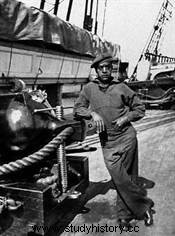 Furthermore, the provisions of the Forfeiture Act authorized the federal government to employ freed blacks as it pleased to help put down the Southern rebellion – which included their previous role as auxiliary workers. But another text, the Militia Act voted on the same day, this time explicitly authorized the northern government to constitute military units including blacks . This was a great novelty, and a great victory for all those who campaigned not only for the abolition of slavery, but also for the rights of African Americans in general.
Furthermore, the provisions of the Forfeiture Act authorized the federal government to employ freed blacks as it pleased to help put down the Southern rebellion – which included their previous role as auxiliary workers. But another text, the Militia Act voted on the same day, this time explicitly authorized the northern government to constitute military units including blacks . This was a great novelty, and a great victory for all those who campaigned not only for the abolition of slavery, but also for the rights of African Americans in general.
Blacks in the army
The idea of arming black people to send them to fight against southerners was controversial for several reasons. The racial prejudices of the time were not foreign to it. For many abolitionists, emancipation did not mean equality, an idea shared by a large part of the rest of the northern white population. The typically human fear of the “outsider” (black, in this case) coming to take land, jobs and even women from the (white) natives – a fear still not extinguished in 2012 – was a key factor in this reluctance. Incidentally, few people, starting with the generals of the federal army, believed that blacks would make good soldiers. However, they had a short memory:African-Americans had already fought during the War of Independence, and all-black units had been formed without demonstrating inferior qualities to those of the white regiments. In a nutshell, what today we would call racism was at work.
The Navy , in this regard, was in a very different state of mind from that of the army. Unlike the latter, she had never prohibited the enlistment of blacks in her crews – if only because the life of a sailor did not attract crowds. Not only were there already African-Americans among its crews in 1861, but they received the same pay as the others. On the other hand, they were generally confined to non-combat roles, and could not claim to exceed the rank of petty officer – the equivalent of master in the French Navy. Compared to what happened in the army, their condition changed only moderately during the Civil War. While they were sometimes admitted as gunners, that was always the exception rather than the rule.
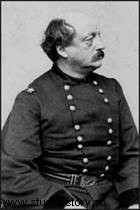 On land, the possibility offered by the Militia Act was not exploited immediately, at least not at the federal level. It's actually the state of Kansas which was the first to react, which was all the more surprising since it had only a few hundred free blacks in 1860. But it was mainly populated by abolitionists and supporters of equality, so that as soon as August 1862, its governor authorized the formation of an infantry regiment, the 1st Kansas Colored Volunteers . “Colored – “of color” – was the euphemism intended to replace the term usually used to designate African-Americans – “Negro “, which then had no pejorative connotation but had become practically synonymous with slave. The unit distinguished itself on October 29, 1862 by repelling an attack by Southern guerrillas in Missouri, at Island Mound, but it was not immediately accepted for service in the Federal army and remained under control until early 1863. of the Kansas Militia.
On land, the possibility offered by the Militia Act was not exploited immediately, at least not at the federal level. It's actually the state of Kansas which was the first to react, which was all the more surprising since it had only a few hundred free blacks in 1860. But it was mainly populated by abolitionists and supporters of equality, so that as soon as August 1862, its governor authorized the formation of an infantry regiment, the 1st Kansas Colored Volunteers . “Colored – “of color” – was the euphemism intended to replace the term usually used to designate African-Americans – “Negro “, which then had no pejorative connotation but had become practically synonymous with slave. The unit distinguished itself on October 29, 1862 by repelling an attack by Southern guerrillas in Missouri, at Island Mound, but it was not immediately accepted for service in the Federal army and remained under control until early 1863. of the Kansas Militia.
Benjamin Butler was quick to emulate the governor of Kansas in resurrecting the Louisiana Native Guard , a militia unit recruited from the free blacks of New Orleans on behalf of the Confederates, who had never accepted it into their army, and disbanded when the Union seized the city in the spring of 1862. D Other Blacks, Unionists these, joined the ranks of the federal version of these units, which were then supplemented by others recruited from among runaway slaves, who were numerous in Louisiana – where nearly half the population was Afro. -American.
These various elements were grouped together in an organization called "Corps d'Afrique ", In french in the text. It was both a reference to the origin of its soldiers, to Louisiana's French past, and to the prestigious Armée d'Afrique - the French troops who served in Algeria. Another African-American unit was formed in more ambiguous circumstances:when in September 1862 the Southern invasion of Kentucky threatened the city of Cincinnati in Ohio, the blacks of the city were conscripted into a "black brigade" which was mainly used for fortification work. The unit was disbanded after a few weeks.
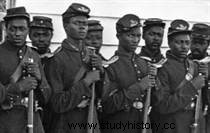 However, the North only embarked on a serious effort to recruit African Americans once the proclamation of emancipation would have taken effect, in 1863. Initially, the organization was the same as for the rest of the army:the regiments were formed under the aegis of the States; or on their behalf by local military officials, in the case of units recruited from runaway slaves from the Confederate States. Thus we find in the lists of northern units of the regiments of Arkansas or Georgia, for example. The majority of them - but not all - were "colored" units.
However, the North only embarked on a serious effort to recruit African Americans once the proclamation of emancipation would have taken effect, in 1863. Initially, the organization was the same as for the rest of the army:the regiments were formed under the aegis of the States; or on their behalf by local military officials, in the case of units recruited from runaway slaves from the Confederate States. Thus we find in the lists of northern units of the regiments of Arkansas or Georgia, for example. The majority of them - but not all - were "colored" units.
In almost all cases, regiments recruited in this way were considered to be supplementary troops distinct from the white-recruited volunteer regiments, and therefore received their own series of numbers – as well as lower pay than white soldiers ($10 a month instead of $16), inequality which was only rectified at the very end of the conflict. Only two states decided to integrate their black units into their volunteer forces:Massachusetts, with two infantry regiments (the 54 th and 55 th ) and one cavalry (the 5 th ); and Connecticut with a single infantry regiment, the 29 th .
All other black units were attached to a section of the War Department, specially created on May 22, 1863 to oversee the recruitment of African-Americans into the army, the Bureau Color Troops. Gradually, the Bureau began to centralize the organization of the regiments and standardized their designation:a single series of numbers for each arm, in which the term United States Colored Troops – United States Colored Troops, abbreviated U.S.C.T. – replaced the names specific to each State. There were in all 135 infantry regiments, 14 artillery (13 "heavy", i.e. fortress, and 1 "light", i.e. field) and 6 of cavalry. 178,000 African-American non-commissioned officers and soldiers served there, supervised by 7,000 white officers.
A black-only officers' school was opened, but very few cadres graduated before the end of the war. Confined to occupation and garrison roles, often neglected in terms of logistics and health, they were most often kept out of the fighting. The northern generals for the most part did not trust them, despite their martial qualities being widely demonstrated when the opportunity arose. Their losses are eloquent:out of approximately 36,000 deaths – a higher rate than that of white soldiers and over a shorter period –
In the long run, black soldiers proved invaluable to the northern war effort. They began to arrive at a crucial time, when volunteers were becoming scarce, and when conscription, finally introduced in March 1863 and applied from July, was struggling to fulfill its role – most of the conscripts drawn by lot reaching so many although difficult to pay the 300 dollars allowing to be exempted, so much so that it was necessary to limit to one year, from 1864, the duration of this exemption. African-Americans provided about ten percent of the total strength of the northern armies, and although they were rarely directly engaged in combat, their employment freed up white units that were. By emancipating Southern slaves, Abraham Lincoln made sure to see the fugitives flocking to northern positions, under the shelter of which they would have the best possible reason to enlist in the federal army:to fight for their freedom and that of their fellows. The first strategic objective of the presidential proclamation was therefore to supply the northern armies with men.
A strategic masterstroke
There were others, with far greater repercussions – and which ultimately weighed heavily in the final Union victory. While his fiercest supporters liked to assert that slavery was the cornerstone of Southern society, and that it would collapse if enslavement were to disappear, he was above all the central pillar of the war economy. Confederate. Most of the adult male population of the South had been mobilized and served in the army:much less populated and therefore suffering from a severe numerical disadvantage on the battlefields, the Confederacy had very early resorted to this unpopular measure, to which successive amendments soon made it impossible to escape. The men who were in the army were no longer in the fields to run the South's essentially rural economy, just as they were absent from its nascent industry, which the war had forced to develop at a rapid pace. The three and a half million slaves of the Confederacy compensated for these absences – partially, because they continued a generally under-skilled workforce and the majority of Southern households did not own slaves.
 However, slaves continued to operate the plantations, cultivating these high-value crops that made the wealth of the South . Admittedly, exports had fallen. The idea of blackmailing the cotton embargo, intended to put pressure on the European powers to recognize the Confederation, had led many planters to turn off the tap of "gold". white", during the first months of the war. They had quickly returned, because the South was sorely lacking in capital, and cotton was its main currency to obtain all that it could not produce on its soil – and that was not what was missing.
However, slaves continued to operate the plantations, cultivating these high-value crops that made the wealth of the South . Admittedly, exports had fallen. The idea of blackmailing the cotton embargo, intended to put pressure on the European powers to recognize the Confederation, had led many planters to turn off the tap of "gold". white", during the first months of the war. They had quickly returned, because the South was sorely lacking in capital, and cotton was its main currency to obtain all that it could not produce on its soil – and that was not what was missing.
In the meantime, the Confederation had to deal with two other problems. First, the blockade of the coasts by the federal navy was beginning to have its effects. However, in 1862, it was still very incomplete and generally not very effective. On the other hand, the loss of New Orleans, and the advance of Union troops along the main western waterways, had greatly disrupted the internal transport of goods, knowing that most of these transited by river before being exported.
Despite everything, there continued to come out of the Confederacy, thanks to the blockade runners, enough cotton to enable the South to exchange it, in England and France, against the uniforms, shoes, medicines, weapons that his armies lacked. This trade was done with the benevolence of the British, who could thus continue to do business while supplying their spinning mills with southern cotton. The port of Nassau, in the Bahamas, thus became a haven for blockade runners, whose northern fleet could not approach without risking violating English neutrality – with all the diplomatic risks that entailed.
So she stayed away from it, which made it that much easier for the southern ships. Proclaiming the emancipation of the slaves of the South, in this context, was also an attempt to remove the problem at the root. By giving them an even stronger incentive to flee their condition, Lincoln made sure at the same time to reduce production , because fewer slaves on the plantations meant less cotton harvested. The corollary would inevitably be a reduction in exports. And less cotton exported meant fewer weapons for the Confederacy.
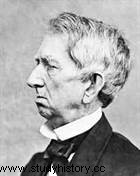 But the march towards abolition was also a diplomatic offensive . In the summer of 1862, with the South regaining the initiative on virtually all fronts and threatening the very territory of the Union, the danger of official recognition of the Confederacy by the United Kingdom and France – and its corollary, that of a potential direct intervention in favor of the Southerners – was perhaps even more acute than in the previous November, at the time of the diplomatic crisis triggered by the incident of Trent . This military threat was materialized, since March 1862, by the presence of a powerful French army in Mexico.
But the march towards abolition was also a diplomatic offensive . In the summer of 1862, with the South regaining the initiative on virtually all fronts and threatening the very territory of the Union, the danger of official recognition of the Confederacy by the United Kingdom and France – and its corollary, that of a potential direct intervention in favor of the Southerners – was perhaps even more acute than in the previous November, at the time of the diplomatic crisis triggered by the incident of Trent . This military threat was materialized, since March 1862, by the presence of a powerful French army in Mexico.
The previous year, the new Mexican President Benito Juarez had suspended interest payments on his foreign debt. France being among the creditors concerned, the Emperor Napoleon III used this pretext to justify an ambitious colonial adventure:to invade Mexico to make it a vassal state of France. Even if their defeat at Puebla on May 5 had forced the French to go on the defensive, it was clear that they would take advantage of the American civil war to have a free hand in Mexico.
Napoleon III therefore had every interest in keeping the United States weakened and divided, and the presence of his troops in Mexico was dangerously close to the federal government. Queen Victoria's government was not to be outdone, insofar as this situation allowed it to strengthen its influence in the Western Hemisphere, after four decades of American imperialism in the region - Monroe doctrine obliges. Hence the discreet aid of Great Britain and France to the Confederation, and the very real risk of seeing this support become more assertive. But if the French and British governments looked at the Confederation with interested benevolence, it was not at all the same for their respective public opinions.
In Britain as in France, the struggle for independence of a nation based on slavery inspired little sympathy, either from English workers or French peasants. The servile institution was too foreign to them, and it was most often seen as archaic and barbaric. This may well be Lincoln's greatest masterstroke:turning the war to restore the Union into a war against slavery , he made sure to rule out any possibility of foreign intervention in favor of the South, because European public opinion would never agree to fly to the aid of the servile institution.
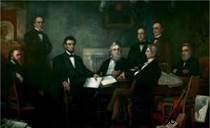 The Slave Emancipation Proclamation:An Ambiguous Document
The Slave Emancipation Proclamation:An Ambiguous Document
The northern president, despite the political risks incurred with such a proclamation, had resolved to resort to it for several weeks. All he needed to put his plan into action was a victory. To enact the Emancipation Proclamation in the midst of the setbacks of the summer of 1862 would have made it look like the desperate measure of a beleaguered government, which would have greatly reduced its impact and, in some respects, even resulted to effects contrary to those intended. The Battle of Antietam was that victory.
It was far from a clear victory, and maybe it was not even a victory at all. However, in the long run, the Emancipation Proclamation would make it a triumph. Antietam had not allowed the northern army to completely push back the enemy on the ground, and even less to annihilate it, while the confrontation had offered a good opportunity to achieve this. However, this battle eventually forced Lee to end his invasion of the North. It therefore represented a defensive victory, which was not without consequences from a symbolic and political point of view. . Indeed, it allowed Lincoln to show the Confederacy not as an emerging nation struggling for independence, but as an invader, struggling to expand an evil institution:slavery. From this point of view, the Emancipation Proclamation came at just the right time.
 To the extent that whether or not the federal government – or even Congress – enjoyed the legal capacity to abolish slavery, had been one of the major debates of the pre-war period, it may seem very surprising that Abraham Lincoln suddenly decided to do so by a simple proclamation. This is a misleading interpretation, simply because in reality, the proclamation of September 22, 1862 did not abolish slavery at all. From a strictly legal point of view, it simply ordered the armed forces of the Union to treat slaves encountered on Confederate territory as free men.
To the extent that whether or not the federal government – or even Congress – enjoyed the legal capacity to abolish slavery, had been one of the major debates of the pre-war period, it may seem very surprising that Abraham Lincoln suddenly decided to do so by a simple proclamation. This is a misleading interpretation, simply because in reality, the proclamation of September 22, 1862 did not abolish slavery at all. From a strictly legal point of view, it simply ordered the armed forces of the Union to treat slaves encountered on Confederate territory as free men.
Lincoln issued it as commander-in-chief of the armies, one of the major prerogatives of the presidential office. Since the military could seize slaves as enemy property under the Confiscation Acts , it could just as easily enfranchise them automatically, by doing so, by order of the president and without requiring either law or constitutional amendment. La proclamation d’émancipation ne faisait qu’anticiper et condenser ce processus. Si les esclaves du Sud étaient émancipés, l’esclavage restait dans le même temps tout à fait légal aux États-Unis.
Ce paradoxe était à l’origine des ambiguïtés véhiculées par la proclamation, à commencer par son extension géographique . L’émancipation ne concernait pas les quatre États esclavagistes demeurés dans l’Union, qu’il s’agisse du Maryland et du Delaware, qui n’avaient jamais fait sécession sous aucune forme que ce soit, ou du Missouri et du Kentucky, dont des législatures dissidentes avaient proclamé le rattachement à la Confédération – leurs législatures majoritaires étant quant à elles restés fidèles à l’Union. Le gouvernement fédéral n’était absolument pas désireux de les obliger à abolir l’esclavage, ne serait-ce que pour ne pas les pousser inutilement à rejoindre le camp sudiste.
Lincoln préférait les inciter à le faire de leur plein gré, répétant à plusieurs reprises que le gouvernement fédéral indemniserait les propriétaires d’esclaves ainsi lésés. Une résolution du Congrès fut d’ailleurs votée en ce sens le 10 avril 1862, promettant le versement d’une indemnité à toute personne qui affranchirait ses esclaves. Pour montrer sa bonne volonté, le cabinet Lincoln lui emboîta aussitôt le pas en abolissant l’esclavage dans le district de Columbia, qu’il administrait directement puisqu’il abritait Washington. La capitale fédérale comptait un peu plus de 3.000 esclaves sur ses 75.000 habitants, et leurs propriétaires furent dédommagés.
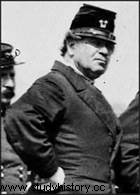 Quant aux onze autres États, ceux qui avaient fait sécession, ils n’étaient eux-mêmes pas forcément concernés dans leur intégralité. La proclamation excluait ainsi la ville de la Nouvelle-Orléans et treize paroisses – l’équivalent louisianais du comté – sous le contrôle des forces nordistes. Les 48 comtés qui formaient alors la Virginie occidentale n’étaient pas non plus concernés. Du reste, la Virginie occidentale – qui s’était séparée de la Virginie après avoir rejeté la sécession de celle-ci – était sur le point d’intégrer l’Union en tant qu’État. Ce serait chose faite le 20 juin 1863, avec une constitution qui autorisait la pratique de l’esclavage. Sont également exclus de la proclamation six autres comtés de Virginie :Accomack et Northampton, isolés sur la rive nord de la baie de Chesapeake et qui n’avaient jamais été sous le contrôle de la Confédération; York et Elizabeth City, autour de la forteresse Monroe, sur la Péninsule de Virginie; et enfin Princess Anne et Norfolk, autour de la ville du même nom. Tous sont alors solidement sous le contrôle militaire de l’Union.
Quant aux onze autres États, ceux qui avaient fait sécession, ils n’étaient eux-mêmes pas forcément concernés dans leur intégralité. La proclamation excluait ainsi la ville de la Nouvelle-Orléans et treize paroisses – l’équivalent louisianais du comté – sous le contrôle des forces nordistes. Les 48 comtés qui formaient alors la Virginie occidentale n’étaient pas non plus concernés. Du reste, la Virginie occidentale – qui s’était séparée de la Virginie après avoir rejeté la sécession de celle-ci – était sur le point d’intégrer l’Union en tant qu’État. Ce serait chose faite le 20 juin 1863, avec une constitution qui autorisait la pratique de l’esclavage. Sont également exclus de la proclamation six autres comtés de Virginie :Accomack et Northampton, isolés sur la rive nord de la baie de Chesapeake et qui n’avaient jamais été sous le contrôle de la Confédération; York et Elizabeth City, autour de la forteresse Monroe, sur la Péninsule de Virginie; et enfin Princess Anne et Norfolk, autour de la ville du même nom. Tous sont alors solidement sous le contrôle militaire de l’Union.
Plus surprenant, la proclamation ne s’appliquait pas non plus au Tennessee . L’homme que Lincoln avait nommé gouverneur militaire de cet État après l’occupation de Nashville, Andrew Johnson, était un des principaux chefs de file des démocrates ralliés à la guerre. Johnson considérait que la sécession du Tennessee, bien que ratifiée par une majorité d’électeurs en juin 1861, était illégale et par conséquent nulle et non avenue. Il arguait ainsi que le Tennessee n’avait jamais quitté l’Union, et que la proclamation d’émancipation, comme pour les quatre autres États esclavagistes restés dans le giron nordiste, ne pouvait lui être appliquée. Lincoln se plia de bonne grâce à cette fiction juridique, alors même que le contrôle militaire de l’Union sur cet État n’était que très incomplet, essentiellement parce que cela lui permettait de se concilier les bonnes grâces à la fois de la frange du parti démocrate qui soutenait le gouvernement fédéral, et des unionistes du Tennessee oriental – bien que ceux-ci fussent encore sous la domination des Sudistes.
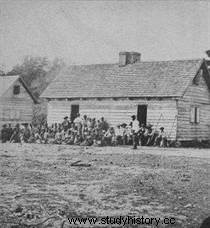
Un premier pas seulement
En définitive, sur l’ensemble du territoire auquel devait s’appliquer la proclamation d’émancipation, une infime partie était réellement occupée par les forces armées nordistes. Ce n’était le cas que de quelques comtés de l’Arkansas, dans le nord de l’État et autour d’Helena, le long du Mississippi; de l’extrême nord de l’État du Mississippi, entre Memphis et Corinth, occupé depuis la prise de cette dernière; de quelques positions dans le nord de l’Alabama, le long de la Tennessee. Les bastions nordistes les plus solidement tenus étaient ceux de la côte de Géorgie et des Carolines, des environs du fort Pulaski à l’île de Roanoke en passant par la passe de Port Royal. Ces zones comportaient une forte proportion d’esclaves, mais elles étaient assez peu densément peuplées, de sorte qu’en tout, la proclamation d’émancipation ne déboucha que sur quelques dizaines de milliers d’affranchissement lors de son entrée en vigueur, le 1 er janvier 1863. C’était peu en comparaison des quatre millions d’esclaves vivant alors aux États-Unis, Nord et Sud confondus.
Le plus grand paradoxe du texte promulgué par Lincoln fut peut-être de parvenir à atteindre autant d’objectifs stratégiques tout en accomplissant si peu. La proclamation, en effet, libérait l’esclavage partout, sauf précisément là où le président nordiste avait le pouvoir de la faire appliquer. En résumé, c’était une coquille vide – mais peut-être une des plus puissantes coquilles vides de l’histoire des États-Unis. Sur le long terme, elle signa l’arrêt de mort de la Confédération, notamment parce qu’elle rendit improbable sa reconnaissance par les puissances européennes. Elle contribua aussi à saper l’effort de guerre sudiste, car chaque avancée des armées nordistes voyait augmenter le nombre de fugitifs ayant quitté leurs plantations. En tant que mesure de guerre, elle remplit pleinement ses objectifs.
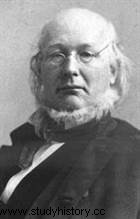 Lincoln, du reste, ne l’avait pas envisagée autrement. Un mois avant sa promulgation, il écrivait à Horace Greeley, le rédacteur en chef du journal républicain New York Tribune :« Mon objectif suprême dans cette lutte est de sauver l’Union, et n’est ni de sauver ni de détruire l’esclavage. Si je pouvais sauver l’Union sans libérer un seul esclave je le ferais, et si je pouvais la sauver en libérant tous les esclaves je le ferais; et si je pouvais la sauver en en libérant certains et pas d’autres je le ferais également . »
Lincoln, du reste, ne l’avait pas envisagée autrement. Un mois avant sa promulgation, il écrivait à Horace Greeley, le rédacteur en chef du journal républicain New York Tribune :« Mon objectif suprême dans cette lutte est de sauver l’Union, et n’est ni de sauver ni de détruire l’esclavage. Si je pouvais sauver l’Union sans libérer un seul esclave je le ferais, et si je pouvais la sauver en libérant tous les esclaves je le ferais; et si je pouvais la sauver en en libérant certains et pas d’autres je le ferais également . »
Il était clair que pour le président nordiste, l’émancipation était avant toute chose un moyen de la guerre qu’il menait, et non une fin de celle-ci. Le caractère restreint et apparemment « creux » de la proclamation d’émancipation était un moyen d’éviter habilement les pièges institutionnels et politiques qu’aurait fait surgir une abolition générale de l’esclavage. La proclamation n’était pas plus qu’un premier pas dans cette direction. Lincoln continua par la suite à proposer aux États esclavagistes encore dans l’Union d’abolir l’esclavage par eux-mêmes, moyennant une indemnité gouvernementale pour les propriétaires lésés. Il restait fidèle à son idée d’une institution disparaissant par elle-même, sans qu’il soit besoin de la supprimer de force.
Plusieurs États finirent par aller dans ce sens, interdisant l’esclavage sur leur territoire alors que la guerre touchait à sa fin. Le Maryland fut le premier à le faire, le 1 er novembre 1864. Le Missouri lui emboîta le pas le 11 janvier 1865, suivi trois jours plus tard du Tennessee – toujours sous l’impulsion d’Andrew Johnson, qui s’apprêtait alors à abandonner son poste de gouverneur militaire de l’État pour celui de vice-président. Le 3 février, enfin, ce fut le tour de la Virginie occidentale. L’esclavage fut également aboli en Louisiane en décembre 1864 :la plus grande partie de l’État était alors occupée par l’armée nordiste, et le gouverneur militaire avait cédé sa place à une administration civile (républicaine) depuis mars de la même année. Dans le même temps, toutefois, l’idée d’une abolition générale avait fait son chemin. Entre décembre 1863 et février 1864, pas moins de quatre propositions majeures d’amendements constitutionnels allant dans ce sens furent soumises au Congrès, aussi bien par des républicains radicaux que par des démocrates pro-guerre. Une synthèse de ces projets fut votée par le Sénat le 8 avril 1864.
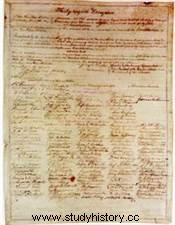 Après avoir été rejetée une première fois par la Chambre des représentants, la proposition reçut le soutien du pouvoir exécutif. À ce stade, les armées nordistes étaient en bien meilleure posture que deux ans plus tôt. Les républicains radicaux étaient soucieux de ne pas voir la mesure de guerre que représentait la proclamation d’émancipation disparaître avec la fin, désormais proche à plus ou moins long terme, des hostilités. Lincoln fut sensible à cet argument et endossa la proposition.
Après avoir été rejetée une première fois par la Chambre des représentants, la proposition reçut le soutien du pouvoir exécutif. À ce stade, les armées nordistes étaient en bien meilleure posture que deux ans plus tôt. Les républicains radicaux étaient soucieux de ne pas voir la mesure de guerre que représentait la proclamation d’émancipation disparaître avec la fin, désormais proche à plus ou moins long terme, des hostilités. Lincoln fut sensible à cet argument et endossa la proposition.
Avec sa réélection, en novembre 1864, l’adoption de l’amendement n’était plus qu’une question de temps, et il fut finalement voté par la Chambre le 31 janvier 1865. Le lent processus de ratification – par les législatures des États, à la majorité des trois quarts – commença aussitôt après. Ce ne fut qu’une formalité dans les États du Sud, désormais occupés par l’armée fédérale et dont les législatures avaient été mises en place sous le contrôle de l’administration militaire. Ironiquement, c’est d’ailleurs l’un d’entre eux, la Géorgie, qui fit entrer en vigueur ce treizième amendement à la constitution – interdisant l’esclavage et accordant l’égalité civique aux Afro-Américains – en le ratifiant le 6 décembre 1865.
La ratification n’alla pas sans quelques accrocs. Le New Jersey dut ainsi s’y reprendre à deux fois pour approuver l’amendement, en février 1866 seulement. Le Texas ne l’accepta qu’au moment de sa réintégration formelle au sein de l’Union, en 1870. Enfin, trois autres États le rejetèrent purement et simplement, et ne le ratifièrent symboliquement que beaucoup plus tard :le Delaware en 1901, le Kentucky en 1976, et le Mississippi – le dernier – en… 1995. Ayant été assassiné le 14 avril 1865, Abraham Lincoln ne vit jamais la fin constitutionnelle de l’esclavage. Il y avait néanmoins contribué plus que tout autre, en premier lieu par l’intermédiaire de sa proclamation d’émancipation. Le treizième amendement était aussi une grande victoire de l’égalité , car il faisait des Noirs des citoyens américains à part entière.
Les républicains radicaux n’avaient pas été désintéressés dans l’adoption de cette mesure, puisqu’elle leur offrait dans le Sud une assise électorale qu’ils n’avaient jamais eue auparavant. Toutefois, cela n’allait pas aller sans heurts, ni durer bien longtemps d’ailleurs :dans les années qui suivirent, les anciens États confédérés trouvèrent toute une panoplie de moyens légaux pour priver les Afro-Américains de leurs droits civiques. Appartenant à un autre chapitre de l’histoire des États-Unis, celui de la « Reconstruction », ces événements allaient être le point de départ d’un siècle de ségrégation.
